Protein is an essential macronutrient that is critical to our overall health.
For those who wish to increase their protein intake, this article provides a list of foods high in protein. Each food displays the amount of protein it contains per 100 grams, per 100 calories, and per typical serving.
The daily value (% DV) for protein based on a 2000-calorie diet is 50 grams per day (1).
However, factors such as age and physical activity levels influence protein requirements.
The source of all nutritional data is the USDA FoodData Central database.
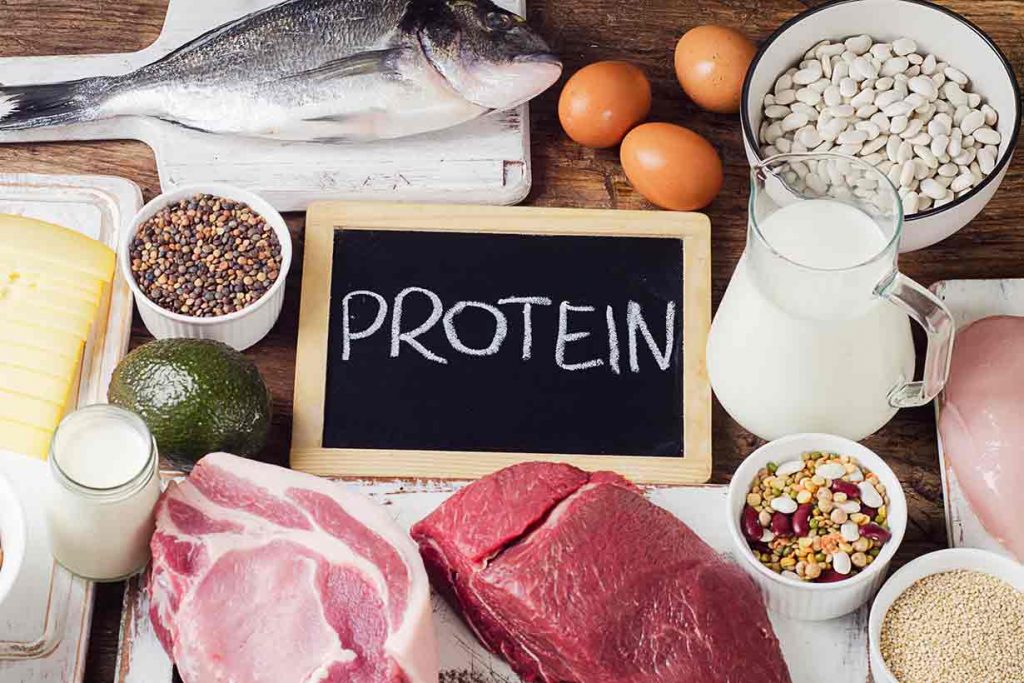
1) Beef, ground, 95% lean, 5% fat, cooked
| Protein per 100 grams | Protein per 3oz (85g) serving | Protein per 100 calories |
|---|---|---|
| 21.4g (49% DV) | 18.2g (36% DV) | 15.6g (31% DV) |
Lean ground beef is a good source of protein, with approximately half of the daily value for protein per 100 grams (2).
2) Beef, top round, lean, cooked
| Protein per 100 grams | Protein per 3oz (85g) serving | Protein per 100 calories |
|---|---|---|
| 35.6g (71% DV) | 30.3g (61% DV) | 19.3g (39% DV) |
Lean top round beef is one of the highest meat sources of protein; a 3oz (85g) serving provides 30.3 grams, 71% of the daily value (3).
3) Cheddar Cheese, fat-free
| Protein per 100 grams | Protein per oz (28.35g) serving | Protein per 100 calories |
|---|---|---|
| 32.1g (64% DV) | 8.99g (18% DV) | 20.4g (41% DV) |
All cheese contains a good source of protein, but fat-free varieties have even more. For example, just an ounce (28.35g) serving of fat-free Cheddar provides 8.99 grams, 18% of the daily value (4).
4) Chicken breast, meat only, cooked
| Protein per 100 grams | Protein per 172g chicken breast | Protein per 100 calories |
|---|---|---|
| 31.0g (62% DV) | 53.4g (107% DV) | 18.8g (38% DV) |
An average-sized cooked chicken breast provides 53.4 grams of protein, 107% of the daily value (5).
Chicken breast is also one of the best sources of the amino acid arginine.
5) Cod, cooked
| Protein per 100 grams | Protein per 180g fillet | Protein per 100 calories |
|---|---|---|
| 22.8g (46% DV) | 41.0g (82% DV) | 21.7g (43% DV) |
A typical (180-gram) cod fillet offers 41 grams of protein, 82% of the daily value (6).
6) Conch, cooked
| Protein per 100 grams | Protein per 127g cup | Protein per 100 calories |
|---|---|---|
| 26.3g (53% DV) | 33.4g (67% DV) | 20.2g (40% DV) |
Conch is one of the best seafood sources of protein; a 127-gram cup serving offers 33.4 grams, 67% of protein’s daily value (7).
7) Cottage cheese, low-fat
| Protein per 100 grams | Protein per 226g cup | Protein per 100 calories |
|---|---|---|
| 11.0g (22% DV) | 24.9g (50% DV) | 13.4g (27% DV) |
All cheese is high in protein, but low-fat cottage cheese is one of the most concentrated sources per calorie. A cup serving provides 24.9 grams, 50% of the daily value (8).
8) Eggs, whole, cooked, poached
| Protein per 100 grams | Protein per large (50g) egg | Protein per 100 calories |
|---|---|---|
| 12.5g (25% DV) | 6.25g (13% DV) | 8.7g (17% DV) |
Eggs are a rich source of protein, with a typical large egg providing 6.25 grams (9).
9) Haddock, cooked
| Protein per 100 grams | Protein per 150g fillet | Protein per 100 calories |
|---|---|---|
| 20.0g (40% DV) | 30.0g (60% DV) | 22.2g (44% DV) |
Lean white fish like haddock offer a rich source of protein; a 150g fillet of cooked haddock provides 30 grams, 60% of the daily value (10).
10) Halibut, cooked
| Protein per 100 grams | Protein per 159-gram half fillet | Protein per 100 calories |
|---|---|---|
| 22.5g (45% DV) | 35.8g (72% DV) | 20.3g (41% DV) |
Halibut is another lean, non-oily fish with a high protein ratio. A typical 159-gram half-fillet serving offers 35.8 grams (11).
11) Lentils, cooked
| Protein per 100 grams | Protein per 198g cup | Protein per 100 calories |
|---|---|---|
| 9.02 g (18% DV) | 17.9g (36% DV) | 7.7g (15% DV) |
A cup of cooked lentils offers 17.9 grams of protein, which is 36% of the daily value (12).
12) Lupin beans, cooked
| Protein per 100 grams | Protein per 166g cup | Protein per 100 calories |
|---|---|---|
| 15.6g (31% DV) | 25.9g (52% DV) | 13.1g (26% DV) |
Lupin beans are one of the most protein-rich legumes (and plant foods in general). A 166-gram cup serving offers 25.9 grams of protein (13).
13) Mozzarella Cheese, fat-free
| Protein per 100 grams | Protein per oz (28.35g) serving | Protein per 100 calories |
|---|---|---|
| 31.7g (63% DV) | 8.99g (18% DV) | 22.5g (45% DV) |
Like fat-free Cheddar, nonfat Mozzarella is also a concentrated source of protein. An ounce (28.35g) serving provides 8.99 grams (14).
14) Mycoprotein, Meatless Grounds
| Protein per 100 grams | Protein per 3-oz (85g) serving | Protein per 100 calories |
|---|---|---|
| 15.3g (31% DV) | 13.0g (26% DV) | 11.8g (24% DV) |
Among the mycoprotein range of meat alternatives, ‘Meatless Grounds’ provides a good amount of protein; 13 grams per 3-ounce (85-gram) serving (15).
15) Octopus, cooked
| Protein per 100 grams | Protein per 3-oz (85g) serving | Protein per 100 calories |
|---|---|---|
| 29.8g (60% DV) | 25.3g (51% DV) | 18.2g (36% DV) |
A three-ounce (28.35g) serving of cooked octopus has 25.3 grams of protein (16).
16) Peanut flour, defatted
| Protein per 100 grams | Protein per oz (28.35g) serving | Protein per 100 calories |
|---|---|---|
| 52.2g (104% DV) | 14.8g (30% DV) | 16.0g (32% DV) |
Peanuts are a rich source of protein, but they also contain high amounts of dietary fat. For this reason, defatted peanut flour provides significant levels of protein. An ounce (28.35g serving provides 14.8 grams, 30% of the daily value (17).
17) Pork, ground, 96% lean, 4% fat, cooked
| Protein per 100 grams | Protein per 3oz (85g) serving | Protein per 100 calories |
|---|---|---|
| 31.7g (63% DV) | 26.9g (54% DV) | 17.1g (34% DV) |
96% lean ground pork is probably the leanest, protein-rich pork product. A 3oz (85-gram) serving contains 26.9 grams of protein (18).
18) Shrimp, cooked
| Protein per 100 grams | Protein per 3oz (85g) serving | Protein per 100 calories |
|---|---|---|
| 24.0g (48% DV) | 20.4g (41% DV) | 24.2g (48% DV) |
Cooked shrimp offers 20.4 grams of protein per 3oz (85g) serving, 41% of the daily value (19).
19) Soybeans, cooked
| Protein per 100 grams | Protein per 172g cup | Protein per 100 calories |
|---|---|---|
| 18.2g (36% DV) | 31.3g (63% DV) | 14.1g (28% DV) |
Soybeans are another protein-rich legume; a 172-gram cup serving of cooked soybeans offers 31.3 grams, 63% of the daily value (20).
20) Soy Protein Isolate
| Protein per 100 grams | Protein per 1oz (28.35g) scoop | Protein per 100 calories |
|---|---|---|
| 88.3g (177% DV) | 25.0g (50% DV) | 26.4g (53% DV) |
Soy protein isolated is a concentrated source of protein, and a typical scoop serving provides 25 grams (21).
21) Tempeh
| Protein per 100 grams | Protein per 166g cup | Protein per 100 calories |
|---|---|---|
| 20.3g (41% DV) | 33.7g (67% DV) | 10.6g (21% DV) |
Like all soy products, tempeh (a fermented soybean dish) offers high levels of protein; 33.7 grams in a typical cup serving (22).
22) Textured Vegetable Protein (TVP)
| Protein per 100 grams | Protein per 68g cup | Protein per 100 calories |
|---|---|---|
| 51.1g (102% DV) | 34.7g (69% DV) | 14.0g (28% DV) |
Textured vegetable protein, also known as TVP, is another soy-based product rich in protein. A cup serving offers 34.7 grams (23).
23) Tofu, firm
| Protein per 100 grams | Protein per 1/2 cup (126g) | Protein per 100 calories |
|---|---|---|
| 17.3g (35% DV) | 21.8g (44% DV) | 12.0g (24% DV) |
Tofu is a good source of protein, but ‘firm’ varieties have higher amounts due to their lower water content. A typical firm tofu provides 21.8 grams of protein per half-cup serving (24).
24) Tuna, light, canned
| Protein per 100 grams | Protein per 165-gram can | Protein per 100 calories |
|---|---|---|
| 25.5g (51% DV) | 42.1g (84% DV) | 22.0g (44% DV) |
Canned ‘light’ tuna is a protein-dense product and contains 42.1 grams per 165-gram can (25).
25) Tuna, yellowfin, cooked
| Protein per 100 grams | Protein per 3oz (85g) serving | Protein per 100 calories |
|---|---|---|
| 29.2g (58% DV) | 24.8g (50% DV) | 22.5g (45% DV) |
A 3oz (85g) serving of cooked yellowfin tuna contains 24.8 grams of protein (26).
26) Turkey Breast, meat only, cooked
| Protein per 100 grams | Protein per 3oz (85g) serving | Protein per 100 calories |
|---|---|---|
| 30.1g (60% DV) | 25.6g (51% DV) | 20.5g (41% DV) |
Turkey breast is one of the most protein-rich meat products. A 3oz (85g) serving of turkey breast without skin provides 25.6 grams (27).
27) Turkey, ground, 93% lean, 7% fat, cooked
| Protein per 100 grams | Protein per 3oz (85g) serving | Protein per 100 calories |
|---|---|---|
| 27.1g (54% DV) | 23.0g (46% DV) | 12.7g (25% DV) |
Lean (7% fat) ground turkey contains 23 grams of protein per 3oz (85g) serving (28).
28) Vital Wheat Gluten
| Protein per 100 grams | Protein per oz (28.35g) serving | Protein per 100 calories |
|---|---|---|
| 75.2g (150% DV) | 21.3g (43% DV) | 20.3g (41% DV) |
Vital wheat gluten is one of the highest protein plant-based foods. It is an ingredient found in seitan and used as a thickener in various recipes. An ounce (28.35g) serving offers 21.3 grams (29).
29) Wheat Germ, toasted
| Protein per 100 grams | Protein per oz (28.35g) serving | Protein per 100 calories |
|---|---|---|
| 29.1g (58% DV) | 8.25g (17% DV) | 7.6g (15% DV) |
Toasted wheat germ is moderately high in protein and offers 8.25 grams per ounce (28.35g) serving (30).
30) Whey Protein Isolate
| Protein per 100 grams | Protein per oz (28.35g) scoop | Protein per 100 calories |
|---|---|---|
| 88.3g (177% DV) | 25.0g (50% DV) | 26.4g (53% DV) |
Like all concentrated protein powders, whey protein isolate offers high dietary protein levels. A typical scoop serving provides 25 grams (31).
Which Foods Have the Highest Protein Content Per Typical Serving?
For a simple comparison, the table below ranks foods high in protein by the amount they provide per typical serving.
| Rank | Food Name | Serving Size | Protein Content |
|---|---|---|---|
| 1 | Tuna, light, canned | 165g can | 42.1g (84% DV) |
| 2 | Chicken breast, meat only, cooked | 172g breast | 53.4g (107% DV) |
| 3 | Cod, cooked | 180g fillet | 41.0g (82% DV) |
| 4 | Halibut, cooked | 159g half fillet | 35.8g (72% DV) |
| 5 | Textured vegetable protein | 68g cup | 34.7g (69% DV) |
| 6 | Tempeh | 166g cup | 33.7g (67% DV) |
| 7 | Conch, cooked | 127g cup | 33.4g (67% DV) |
| 8 | Soybeans, cooked | 172g cup | 31.3g (63% DV) |
| 9 | Beef, top round, lean, cooked | 3 oz (85g) | 30.3g (61% DV) |
| 10 | Haddock, cooked | 150g fillet | 30.0g (60% DV) |
| 11 | Pork, ground, 96% lean, cooked | 3 oz (85g) | 26.9g (54% DV) |
| 12 | Lupin beans, cooked | 166g cup | 25.9g (52% DV) |
| 13 | Turkey breast, meat only, cooked | 3 oz (85g) | 25.6g (51% DV) |
| 14 | Octopus, cooked | 3 oz (85g) | 25.3g (51% DV) |
| 15 | Whey protein isolate | 28.35g scoop | 25.0g (50% DV) |
| 16 | Soy protein isolate | 28.35g scoop | 25.0g (50% DV) |
| 17 | Cottage cheese, low-fat | 226g cup | 24.9g (50% DV) |
| 18 | Tuna, yellowfin, cooked | 3 oz (85g) | 24.8g (50% DV) |
| 19 | Turkey, ground, 93% lean, cooked | 3 oz (85g) | 23.0g (46% DV) |
| 20 | Tofu, firm | 1/2 cup (126g) | 21.8g (44% DV) |
| 21 | Vital wheat gluten | 1 oz (28.35g) | 21.3g (43% DV) |
| 22 | Shrimp, cooked | 3 oz (85g) | 20.4g (41% DV) |
| 23 | Beef, ground, 95% lean, cooked | 3 oz (85g) | 18.2g (36% DV) |
| 24 | Lentils, cooked | 198g cup | 17.9g (36% DV) |
| 25 | Peanut flour, defatted | 1 oz (28.35g) | 14.8g (30% DV) |
| 26 | Mycoprotein, Meatless Grounds | 3 oz (85g) | 13.0g (26% DV) |
| 27 | Cheddar cheese, fat-free | 1 oz (28.35g) | 8.99g (18% DV) |
| 28 | Mozzarella cheese, fat-free | 1 oz (28.35g) | 8.99g (18% DV) |
| 29 | Wheat germ, toasted | 1 oz (28.35g) | 8.25g (17% DV) |
| 30 | Egg, whole, cooked, poached | One large egg | 6.25g (13% DV) |
Commonly Asked Questions
For further information, here are some answers to commonly asked questions about foods high in protein.
Generally, the highest protein foods per gram include lean meat and fish, fat-free cheese, legumes like soybeans and lupin beans, and concentrated protein powders.
The best options for high protein and fiber are soybeans and lupin beans. Mycoprotein products also contain some fiber.
Protein powders had the most protein per calorie from the foods featured in this guide. From the whole food options, those with the highest protein per calorie included lean fish like cod, haddock, and tuna.
Almost all of the foods in this guide are suitable for a high protein, low carb diet. However, the lean fish and meat options contain virtually no carbohydrates, whereas legumes like soybeans offer moderate amounts.
Related Articles
The Protein Content of 230 Common Foods


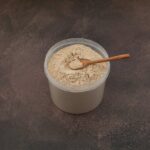
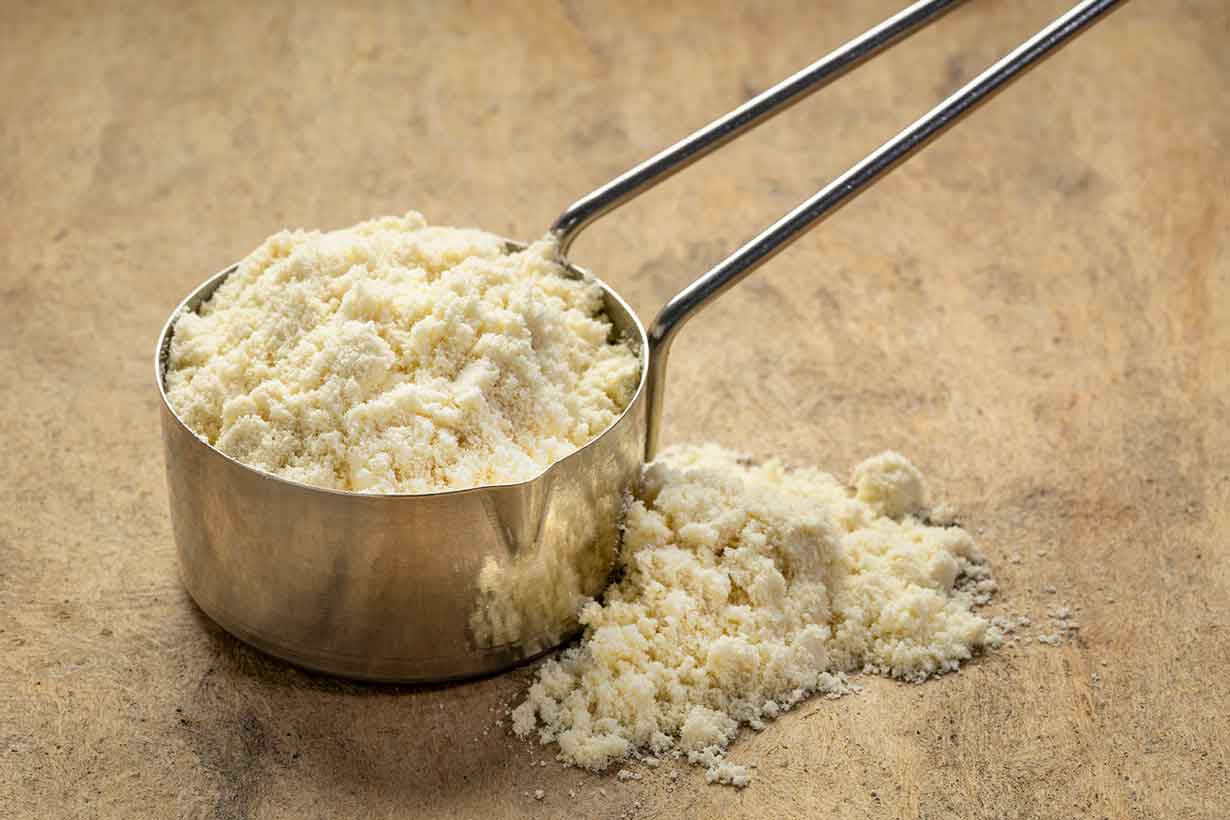

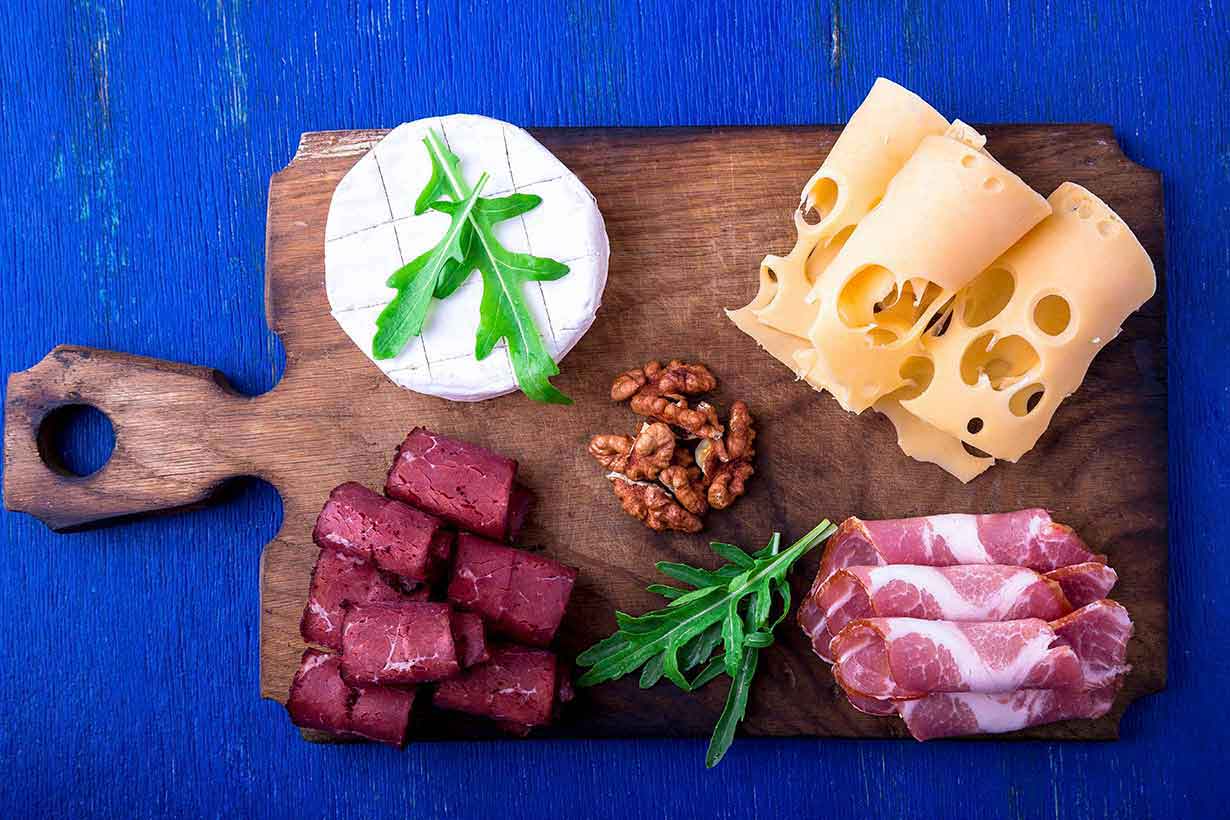


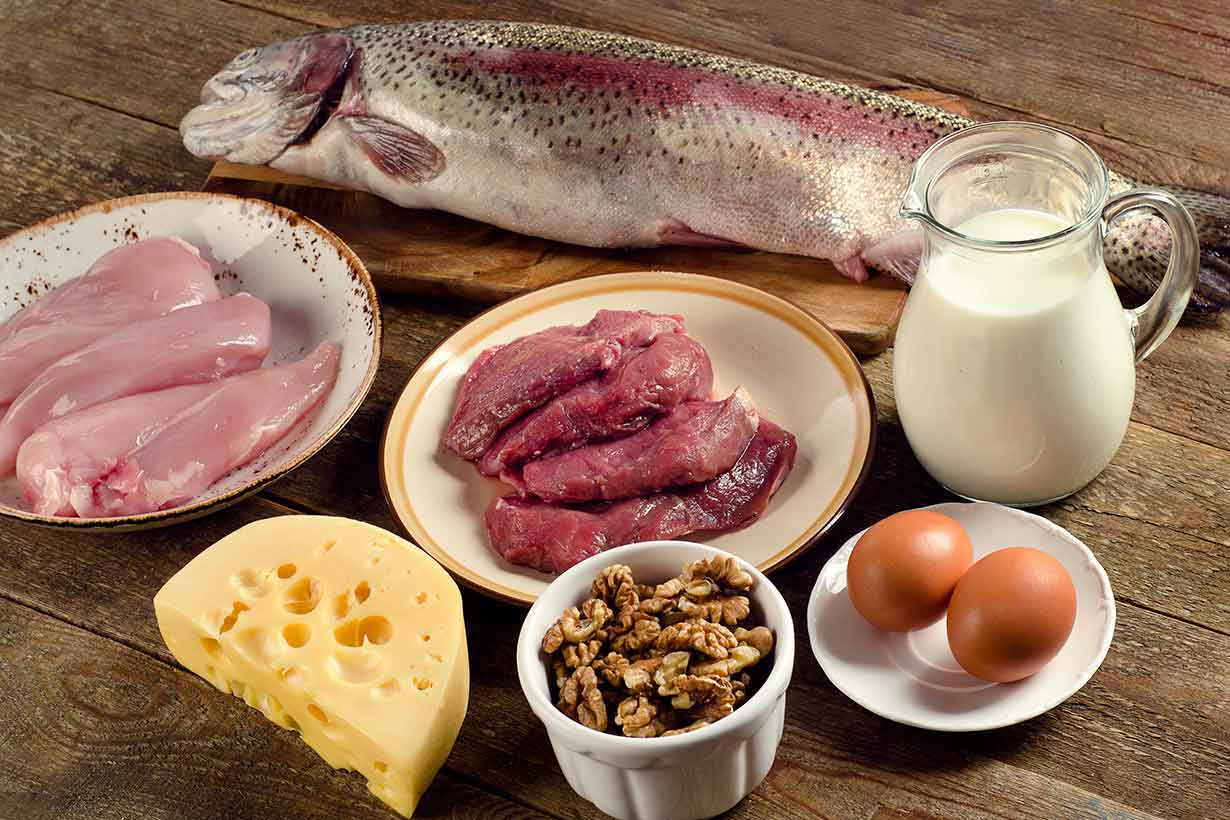
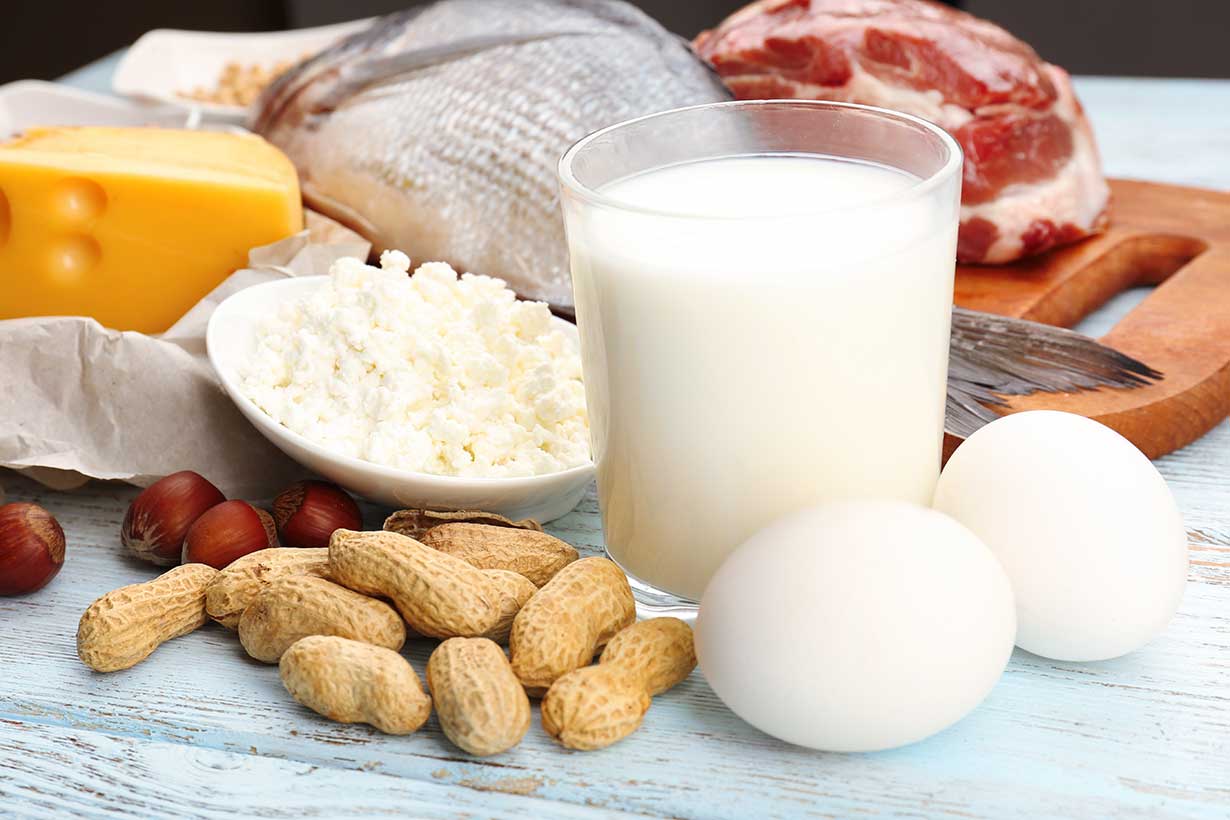
Very informative article. But could you please give list of high protein food that vegetarians can eat?
Thanks and regards.
Thanks, and sure – I will try to do that soon.
Hempseeds. Taste like nuts, very pleasant, 35-36g of protein per 100g. That is higher than most meats or at least the same amount, excellent quality protein: highly absorbable, extensive amino acid content. They produce hempseed protein powder if you want to avoid fats (has lots of healthy omegas 45g per 100g). I would look into seeds more (like chia), exotic berries and other superfoods, and of course, spirulina & chlorella are very high in protein. This way you will get healthier fat, boost minerals, vitamins and antioxidants. These and less omega 6 more omega 3 will work to decrease inflammation. You will also have fewer cravings or acute hunger, will feel more satisfied and stay full for longer. A lot of the superfoods (e.i. chia) regulate blood sugar and other things, they also supply energy for a longer time. This actually brought me closer to a vegan diet (I am a vegi). I felt better off lactose, wheat and sugar (all things filling and inflammatory).
General advice based on experience and common sense:
Do not just think in terms of protein, educate yourself all-round about nutrition. There is always a surprising effect when taken a sophisticated approach. Also imagination, there are so many great diets, cousins and super healthy stuff to take inspiration in and make up your own nutritional plan. Study foods, mind and the body to find a great solution for your case.
Lentils may be 25g protein/100g but only when dried. They’re around 6g/100g when cooked.
Correct – that’s right, but all the values here are for raw weight to keep it fair.
What about soyabean?
Soybeans offer approx 16.5 grams of protein per 100 grams (cooked).